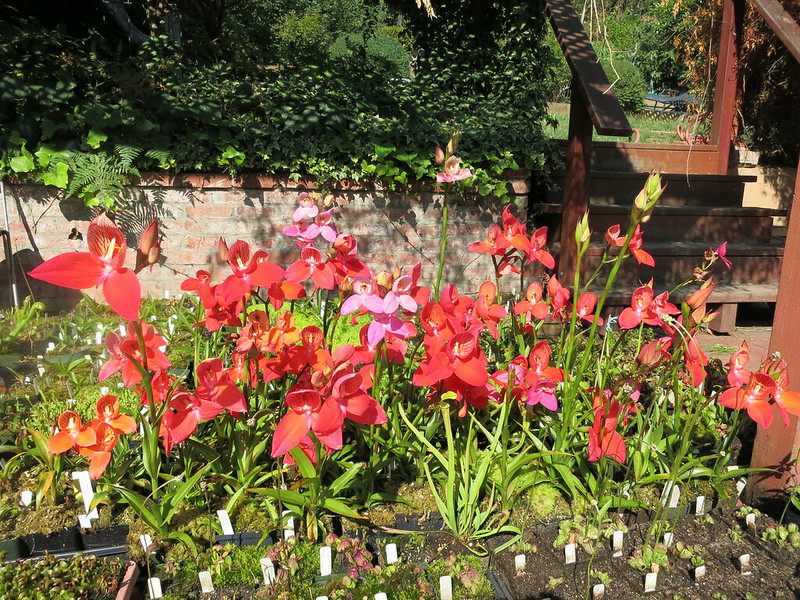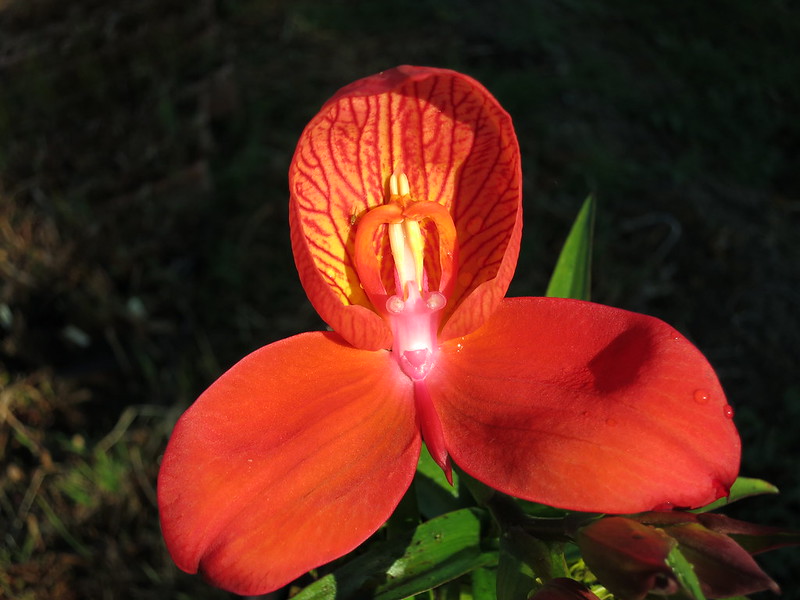


Donate Now
and become
Forum Supporter.

Many perks!
<...more...>


|

03-16-2017, 05:25 PM
|
|
Jr. Member
|
|
Join Date: Mar 2017
Posts: 7
|
|
 The future of Disas in cultivation, pics!
The future of Disas in cultivation, pics!
It seems there are less and less people out there attempting to grow Disas these days. This is probably because they're tricky to really understand and grow year after year. Even experienced growers have their setback with disease outbreaks (mainly fungal) and can go from hundreds of plants to just dozens over a few grow seasons. After flowering, some plants just don't come back for various reasons.
No matter how many grow guides you read, nothing prepares you to grow these plants better than jumping into it and trying it yourself! I've grown Disas in weather where we had 116F (47C) for 2 weeks straight and they all survived! The key is, it always dropped to 65F (18C) at night and if the nights were in the low 70's (21C), the warm nights wouldn't last for more than a week.
In contrast, I've burned Disas grown in morning sun and afternoon shade, even when the temperature didn't go above 65F(18C), so finding the right balance of light and temperature takes a little trial and error. Interestingly, some clones can tolerate more sunlight than others.
While many out there explain that the #1 killer of Disa orchids is rot, they don't really mention some of the key reasons rot occurs. What I've observed is under optimal, cool temperatures, if the humidity is high and light is low, rot can be avoided if the plants aren't growing fast, medium is kept damp but not very wet, and the soil is very nutrient poor.
Even during times when we have low humidity, rot sets in if you fertilize to the point that the plant is growing strong and fast. It's very counter-intuitive:stressed out plants are more resistant than healthy, fast growing plants. As a grower, you want to get those plants as big and fat as possible yet avoid rot which can end it all.
Here's a photo of the height of my disa collection from the summer of 2013 when the collection rose to over a few hundred plants. They were transplanted and all were fed well in the fall, but then rot started during the winter rainy season so they were "starved" and the rot disappeared. This location had the best climate ever:it was at the bottom of a hill, got only morning direct sunlight, but diffused, afternoon light all year round, and it stayed relatively cool because cool air from the ocean seep into the area every night.

Challenge is, most of what bloomed didn't come back that fall, all the energy went into flowering and little went into replacing the plantlets. To top things off, we had a few days of mild frost in the winter of 2014, which wiped out about 70% of the plants.
I then moved to a new location that only gets morning sun and then pure afternoon shade. The plants adapted well, but because of the move, they weren't repotted, so many declined and perished by 2015 (this was the year my daughter was born, so plants were very neglected). By 2016, only a dozen or so pots were hanging on, and then some workers dumped top soil on the entire collection. A few plants perished, but I salvaged whatever was left and acquire a few more plants to get things going again. Some of my old, 'kill proof' clones had really nice sized tubers!
---------- Post added at 01:25 PM ---------- Previous post was at 01:23 PM ----------
Hmmm, I'm giving up, there's a lot more to this post that I wrote, but I lost it all from getting the error message regarding photo limits. Oh well....

|
|
Post Thanks / Like - 6 Likes
|
|
|
|
|

03-16-2017, 11:48 PM
|
|
Senior Member
|
|
Join Date: Jul 2009
Zone: 6a
Location: Columbus, Ohio
Posts: 2,452
|
|
I have always loved disas but I seriously doubt I could grow them. Those were beautiful! I don't think I have ever seen so many....excellent job.
|

03-17-2017, 01:52 AM
|
 |
Senior Member
|
|
Join Date: Jun 2015
Zone: 9b
Location: Phoenix AZ - Lower Sonoran Desert
Posts: 18,586
|
|
Welcome, and thank you for showing us!
There are some excellent threads here by people who have figured out how to grow Disas. If you use the Search function in the top maroon menu you can find them.
|

03-17-2017, 03:14 AM
|
|
Senior Member
|
|
Join Date: May 2015
Posts: 351
|
|
Welcome to the forum Mike! It's funny how I saw Disa and immediately thought it had to be you haha
Of course, I'm sure you'll have to add pics of some of the other bog orchids you've got and their carnivorous pot mates  |

03-17-2017, 05:20 AM
|
|
Senior Member
|
|
Join Date: Jan 2008
Location: España
Posts: 496
|
|
Awesome ...
|

03-17-2017, 02:22 PM
|
|
Jr. Member
|
|
Join Date: Mar 2017
Posts: 7
|
|

SFL guy-great to see you here, it's a small world! Suppose the Sarracenia Forum has me really spoiled when it comes to posting pictures....
Thanks for all the positive feedback everyone! Regarding some of the text that got erased, I wanted to discuss flower timing: here in Northern California, Disas tend to bloom from June thru end of July. However, this year I have one pot that just started blooming right now! Clones of this exact plant growing in the exact same environment (watering, light, everything) are on target to bloom in June. So why is this plant flowering now?
Still not positive, but I think it has something to do with when the new growth emerged from the tuber. Last spring, I suspect the plant in bloom died because the growth had a terminal leaf and then senesced. There was a large tuber, so a new growth emerged and had an incredible boost in growth and development since that tuber was loaded with nutrients and was only focused on the new plantlet. Normally, new plantlets pop up in the spring, but these little babies won't have accelerated growth because the mother plant typically is eating up most of the nutrients.
Long story short, if you can figure out how to make disa plants with tubers die off naturally in the spring and get replaced by new growth, this might be one way to get them to bloom earlier! Normally, growth dies off naturally in the late summer to early fall and is replaced by one or several new plantlets.
Here's Disa 'Glasgow Orchid Conference', it's maybe 3-4" tall (very short for this clone, which is usually much taller), and it has 5 flower buds in it! Photo taken 3/17/17:

Last edited by meizzwang; 03-17-2017 at 03:49 PM..
|
|
Post Thanks / Like - 4 Likes
|
|
|
|
|

03-17-2017, 02:39 PM
|
 |
Senior Member
|
|
Join Date: May 2005
Location: Oak Island NC
Posts: 15,159
|
|
First, let me say that those are fantastic!
I'm going to disagree with an earlier statement, but I think we are really thinking the same thing:
Stressed-out plants are definitely NOT more resistant to diseases - quite the opposite, in fact.
I think where we differ is simply in your assessment that the well-fed, fast growing plant is not stressed, while the one with meager nutrition is. I think it's just the opposite. Overfeed any plant, and it will succumb much more readily than one that is underfed.
And when you consider that the nutrient demands of orchids vary all over the map, but as a whole are quite slim compared to terrestrial plants, it might be particularly easy to stress out disas by overfeeding.
|

03-17-2017, 03:15 PM
|
|
Jr. Member
|
|
Join Date: Mar 2017
Posts: 7
|
|

Thanks for the feedback Ray! Looks like things were a little too over-simplified, so here's some more details:You are correct, a stressed plant will be more susceptible to rot, and what I'm referring to is nutrient stress, which is not necessarily a stressed out plant. This merely means the plant is growing at below optimal rates and has a higher ratio of lignin to leaf mass compared to a fast growing, well fed plant.
Disas that are fed very low levels of fertilizer have less photosynthate stored and moving about in their tissues, giving fungi and bacteria a lower probability of colonizing a section of their leaves.
When Disas are growing really fast and are fertilized well, their roots are solid white, which would suggest they aren't under stress and are in fact in optimal health. However, go slightly too high with fertilizers and perhaps this is the state of stress you're referring to.
Happy, fat, and healthy doesn't mean stressed, but in my experience it does mean higher susceptibility to disease because there's more food available and less physical barriers protecting the roots and shoots. Same concept is applicable to most plants. Such overly pumped plants produce thinner layers of wax and have cells that are less lignified compared to a plant growing slowly and steadily.

|

03-17-2017, 04:31 PM
|
|
Senior Member
|
|
Join Date: May 2015
Posts: 351
|
|
Quote:
Originally Posted by meizzwang

SFL guy-great to see you here, it's a small world! Suppose the Sarracenia Forum has me really spoiled when it comes to posting pictures....
|
That it does haha |

03-17-2017, 05:16 PM
|
|
Senior Member
|
|
Join Date: Apr 2012
Zone: 2a
Location: Fairbanks, AK
Posts: 975
|
|
There are some research done with regard to Disa growing. I think the problem you are describing is that their physiology is sensitive to fertilization level. With more fertilizer, they produced beautiful leaves, but they increase shoot:root ratio (more shoot biomass per root biomass). Also, they prematurely flower, and die because they don't produce the tuber for the next year. I wouldn't call it as "stress", it is more of their adaptation (which isn't "adaptive" in some cultivated conditions).
|
|
Currently Active Users Viewing This Thread: 1 (0 members and 1 guests)
|
|
|
 Posting Rules
Posting Rules
|
You may not post new threads
You may not post replies
You may not post attachments
You may not edit your posts
HTML code is Off
|
|
|
All times are GMT -4. The time now is 06:36 PM.
|

































 Linear Mode
Linear Mode


